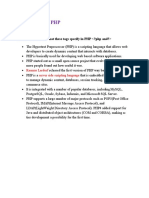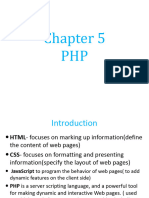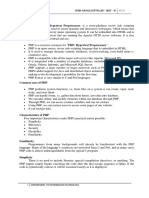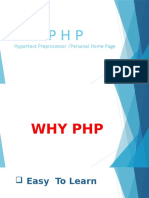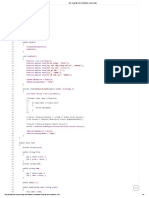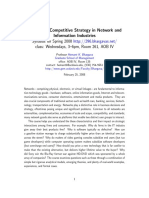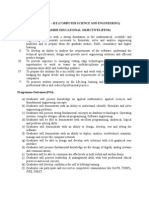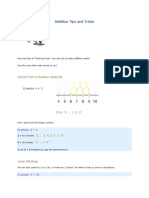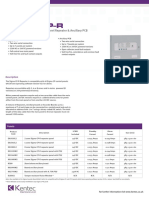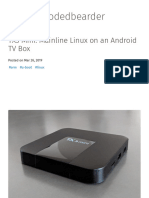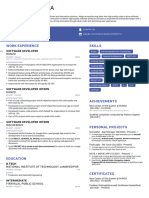PHP Programming
Uploaded by
suryaPHP Programming
Uploaded by
suryaDr.
S Surya
PHP Programming
UNIT I
Introduction to PHP -Basic Knowledge of websites -Introduction of Dynamic Website -
Introduction to PHP -Scope of PHP -XAMPP and WAMP Installation
UNIT II
PHP Programming Basics -Syntax of PHP -Embedding PHP in HTML -Embedding HTML in PHP.
Introduction to PHP Variable-Understanding Data Types -Using Operators -Using Conditional
Statements -If(), else if() and else if condition Statement.
UNIT III
Switch() Statements -Using the while() Loop -Using the for() Loop PHP Functions. PHP
Functions -Creating an Array - Modifying Array Elements -Processing Arrays with Loops -
Grouping Form Selections with Arrays -Using Array Functions.
UNIT IV
PHP Advanced Concepts -Reading and Writing Files -Reading-Data from a File.
UNIT V
Managing Sessions and Using Session Variables -Destroying a Session -Storing Data in Cookies -
Setting Cookies.
UNIT I
Introduction to PHP -Basic Knowledge of websites -Introduction of Dynamic Website -
Introduction to PHP -Scope of PHP -XAMPP and WAMP Installation.
PHP Introduction
The term PHP is an acronym for – Hypertext Preprocessor. PHP is a server-side scripting
language designed specifically for web development. It is an open-source which means it is free
to download and use. It is very simple to learn and use. The file extension of PHP is “.php”.
What is PHP?
PHP is a server-side scripting language created primarily for web development but it is also
used as a general-purpose programming language. Unlike client-side languages like JavaScript,
which are executed on the user’s browser, PHP scripts run on the server. The results are then
sent to the client’s web browser as plain HTML.
History of PHP
PHP was introduced by Rasmus Lerdorf in 1994, the first version and participated in the later
versions. It is an interpreted language and it does not require a compiler. The language quickly
evolved and was given the name “PHP,” which initially named was “Personal Home Page.”
PHP 3 (1998): The first version considered suitable for widespread use.
PHP 4 (2000): Improved performance and the introduction of the Zend Engine.
PHP 5 (2004): Added object-oriented programming features.
PHP 7 (2015): Significant performance improvements and reduced memory usage.
1
Dr.S Surya
PHP 8 (2020): Introduction of Just-In-Time (JIT) compilation, further enhancing
performance.
Characteristics of PHP
PHP code is executed in the server.
It can be integrated with many databases such as Oracle, Microsoft SQL Server, MySQL,
PostgreSQL, Sybase, and Informix.
It is powerful to hold a content management system like WordPress and can be used to
control user access.
It supports main protocols like HTTP Basic, HTTP Digest, IMAP, FTP, and others.
Websites like www.facebook.com and www.yahoo.com are also built on PHP.
One of the main reasons behind this is that PHP can be easily embedded in HTML files
and HTML codes can also be written in a PHP file.
The thing that differentiates PHP from the client-side language like HTML is, that PHP
codes are executed on the server whereas HTML codes are directly rendered on the
browser. PHP codes are first executed on the server and then the result is returned to the
browser.
The only information that the client or browser knows is the result returned after
executing the PHP script on the server and not the actual PHP codes present in the PHP
file. Also, PHP files can support other client-side scripting languages like CSS and
JavaScript.
How PHP Works?
PHP scripts are executed on the server. Here’s a typical flow of how PHP works:
A user requests a PHP page via their web browser.
The server processes the PHP code. The PHP interpreter parses the script, executes the
code, and generates HTML output.
The server sends the generated HTML back to the client’s browser, which renders the
web page.
This server-side processing allows for dynamic content generation and ensures that sensitive
code is not exposed to the client.
Syntax
<?php
// PHP code goes here
?>
2
Dr.S Surya
Basic Example of PHP
<!DOCTYPE html>
<html>
<head>
<title>PHP Hello World</title>
</head>
<body>
<?php echo "Hello, World! This is PHP code";?>
</body>
</html>
Output:
Hello, World! This is PHP code
PHP Installation and Configuration
To get started with PHP, you need to set up a local environment. Here’s a simple guide:
Install a Web Server: Apache or Nginx are popular choices.
Install PHP: Download and install the latest version of PHP from the official PHP
website.
Install a Database: MySQL or MariaDB are commonly used with PHP.
Configure PHP: Update the php.ini file to configure PHP settings as needed.
For beginners, a complete package like XAMPP (Windows) or MAMP (macOS) is recommended,
as it comes bundled with Apache, PHP, and MySQL.
Features of PHP
Dynamic Typing: PHP is dynamically typed, meaning you don’t need to declare the data
type of a variable explicitly.
Cross-Platform: PHP runs on various platforms, making it compatible with different
operating systems.
Database Integration: PHP provides built-in support for interacting with databases,
such as MySQL, PostgreSQL, and others.
Server-Side Scripting: PHP scripts are executed on the server, generating HTML that is
sent to the client’s browser.
Applications of PHP
PHP is versatile and can be used in a variety of web development scenarios, including:
Dynamic Web Pages: Generating dynamic content based on user interaction or other
conditions.
Content Management Systems (CMS): Many popular CMSs like WordPress, Joomla, and
Drupal are built with PHP.
E-commerce Platforms: PHP is commonly used to develop e-commerce websites due to
its database integration capabilities.
3
Dr.S Surya
Web Applications: PHP is used for creating feature-rich web applications such as social
media platforms, forums, and customer relationship management (CRM) systems.
API Development: PHP can be used to create APIs for web and mobile applications.
Why should we use PHP?
PHP can actually do anything related to server-side scripting or more popularly known
as the backend of a website. For example, PHP can receive data from forms, generate dynamic
page content, can work with databases, create sessions, send and receive cookies, send emails,
etc. There are also many hash functions available in PHP to encrypt users’ data which makes
PHP secure and reliable to be used as a server-side scripting language. So these are some of
PHP’s abilities that make it suitable to be used as a server-side scripting language. You will get to
know more of these abilities in further tutorials.
Even if the above abilities do not convince you of PHP, there are some more features of PHP. PHP
can run on all major operating systems like Windows, Linux, Unix, Mac OS X, etc. Almost all of
the major servers available today like Apache supports PHP. PHP allows using a wide range of
databases.
Advantages of PHP
Open Source: PHP is an open-source language, meaning it is freely available for anyone
to use and distribute. This openness has fostered a large and active community of
developers who continuously contribute to its growth, improvement, and feature
development.
Easy to Learn: The syntax of PHP is quite similar to C and other programming
languages. This makes PHP relatively easy to learn, especially for developers who
already have some programming experience. Beginners find it approachable due to its
straightforward syntax and extensive online resources.
Web Integration: PHP is designed specifically for web development and is embedded
within HTML. It seamlessly integrates with various web technologies, facilitating the
creation of dynamic and interactive web pages.
Database Support: PHP has excellent support for various databases, including MySQL,
PostgreSQL, SQLite, and more. This makes it easy to connect and interact with databases,
a crucial aspect of many web applications.
Cross-Platform Compatibility: PHP is platform-independent and runs on various
operating systems, including Windows, Linux, macOS, and others. This ensures
compatibility across different environments.
Large Community and Documentation: PHP has a vast and active community of
developers. The abundance of online resources, tutorials, and documentation makes it
easier for developers to find solutions and seek help when needed.
Frameworks and CMS: There are popular PHP frameworks like Laravel, Symfony, and
CodeIgniter, which provide pre-built modules and features, aiding in rapid development.
Additionally, PHP supports widely used content management systems (CMS) like
WordPress and Joomla.
4
Dr.S Surya
Server-Side Scripting: PHP scripts are executed on the server, reducing the load on the
client’s side. This server-side scripting capability is crucial for generating dynamic
content and performing server-related tasks.
Community Support: The PHP community actively contributes to the language’s
development, ensuring regular updates, security patches, and improvements.
Disadvantages of PHP
Inconsistency: PHP has been criticized for inconsistencies in function names and
parameter orders. This can lead to confusion for developers, especially when working
with a mix of older and newer functions.
Security Concerns: If not handled properly, PHP code may be susceptible to security
vulnerabilities, such as SQL injection and cross-site scripting (XSS). Developers need to
be cautious and follow best practices to secure PHP applications.
Performance: While PHP performs well for many web applications, it may not be as fast
as some compiled languages like C or Java. However, advancements and optimizations in
recent versions have improved performance.
Lack of Modern Features: Compared to newer languages, PHP may lack some modern
language features. However, recent versions of PHP have introduced improvements and
features to address this concern.
Scalability Challenges: PHP can face challenges when it comes to scaling large and
complex applications. Developers may need to adopt additional tools or frameworks to
address scalability issues.
Not Suitable for Large-Scale Applications: While PHP is suitable for small to medium-
sized projects, it might not be the best choice for extremely large and complex
applications where more structured languages might be preferred.
Limited Object-Oriented Programming (OOP) Support: Although PHP supports OOP,
its implementation has been criticized for not being as robust as in some other
languages. However, recent versions have introduced improvements to enhance OOP
capabilities.
Basic Knowledge of Websites Using PHP
PHP plays a central role in the development of dynamic websites. These are
websites that interact with users, handle forms, databases, authentication, and more.
If you're learning PHP for web development, here's an overview of how PHP is
commonly used to build websites.
1. What is a Dynamic Website?
A dynamic website is one whose content can change or update based on user
interactions or data retrieved from databases. PHP, being a server-side language, is
widely used for these kinds of websites.
5
Dr.S Surya
Examples of dynamic websites:
User dashboards
Content Management Systems (CMS)
E-commerce platforms
Social networks
Static websites, on the other hand, contain fixed content and don't change based
on user input. Static sites are usually written in HTML, CSS, and JavaScript, but PHP
is not typically used on these sites.
2. PHP in Website Development
PHP is a server-side scripting language, which means it runs on the web server
rather than in the user's browser. This allows PHP to generate dynamic content,
interact with databases, and manage session states for each user.
Server-side processing: The browser sends requests to the server, and PHP
processes these requests to return HTML, data, or any other content to the client.
Database interaction: PHP is commonly used in combination with MySQL (or
other databases) to store and retrieve data, such as user accounts, posts, product
listings, and more.
Session management: PHP can maintain user sessions, helping to manage
logins, shopping carts, and personalized content.
3. How PHP Works in a Website
A typical website using PHP works as follows:
1. User Requests a Page: The user types a URL in the browser or clicks a link.
2. Request Sent to Web Server: The request is sent to the server where the PHP
file is located.
3. PHP Script Executes: The PHP code runs on the server. It may:
o Retrieve data from a database.
o Process form input.
o Generate dynamic content based on conditions or user actions.
4. Output Sent to Browser: The PHP script sends HTML, CSS, and JavaScript back
to the user’s browser, which renders the page.
4. PHP and Web Pages
A PHP file typically ends with the .php extension and can contain both PHP code
and HTML. This allows dynamic content to be embedded directly within static HTML
pages.
6
Dr.S Surya
Example of a simple PHP page:
<?php
// Example of connecting to a MySQL database in PHP
$servername = "localhost";
$username = "root";
$password = "";
$dbname = "my_database";
// Create connection
$conn = new mysqli($servername, $username, $password, $dbname);
// Check connection
if ($conn->connect_error) {
die("Connection failed: " . $conn->connect_error);
}
$sql = "INSERT INTO users (username, email) VALUES ('JohnDoe',
'john@example.com')";
if ($conn->query($sql) === TRUE) {
echo "New record created successfully";
} else {
echo "Error: " . $sql . "<br>" . $conn->error;
}
$conn->close();
?>
3. Session Management
PHP can manage user sessions, which is useful for login systems and other user-
specific interactions.
<?php
// Start a session
session_start();
// Store data in session
$_SESSION['username'] = 'JohnDoe';
// Access session data on another page
echo $_SESSION['username']; // Output: JohnDoe
?>
4. Content Management Systems (CMS)
Many popular CMS platforms, like WordPress, Joomla, and Drupal, are built with PHP. These
systems allow users to easily manage and publish content without needing to write code.
7
Dr.S Surya
PHP handles database interactions (posts, pages, media) and the logic behind the
content.
Templates and themes are used to display the content dynamically.
5. E-commerce Websites
PHP is often used in building e-commerce websites (like shopping carts, product catalogs, order
management, etc.).
Shopping carts: PHP stores temporary data (cart items) in sessions or databases.
Product listings: PHP retrieves product data from a database and displays it dynamically
on the page.
6. PHP Frameworks for Websites
When building more complex websites, developers often use PHP frameworks to streamline
development. These frameworks provide structure, reusable code, and additional features to
simplify the process.
Popular PHP frameworks:
Laravel: A modern, elegant framework that offers many tools for building web
applications (routing, templating, security, etc.).
Symfony: A flexible and powerful framework for complex websites and applications.
CodeIgniter: A lightweight, easy-to-learn framework ideal for beginners.
7. Security Considerations
When developing websites with PHP, security is a key concern. Some common security issues
include:
SQL Injection: Prevent this by using prepared statements or ORM (Object-Relational
Mapping) tools.
Cross-Site Scripting (XSS): Sanitize and escape user input (e.g., using
htmlspecialchars()).
Cross-Site Request Forgery (CSRF): Use tokens to protect forms from CSRF attacks.
Password Storage: Use PHP's password_hash() and password_verify() functions to
securely hash and verify user passwords.
8. PHP and Web Servers
To run PHP on a website, you'll need a web server that supports PHP. Two common options are:
Apache: The most popular web server used with PHP. It often works alongside MySQL in
a LAMP stack (Linux, Apache, MySQL, PHP).
Nginx: A fast and scalable web server, often paired with PHP through PHP-FPM (FastCGI
Process Manager).
Conclusion
PHP is essential for building dynamic websites, allowing for interactions with users, databases,
and content management systems. Its ability to integrate with HTML, handle form data, manage
sessions, and connect to databases makes it one of the most popular choices for web
development. Understanding how PHP interacts with the server, client, and database will help
you build powerful and interactive websites.
Dynamic Websites in PHP
A dynamic website is a type of website that generates content on the fly, based on user
interactions, database queries, or other conditions. Unlike static websites, which display fixed
8
Dr.S Surya
content that doesn't change unless manually edited, dynamic websites can update and modify
their content in real time.
PHP is one of the most commonly used programming languages for creating dynamic websites.
It allows web developers to build server-side logic that can interact with databases, manage user
input, and personalize content for visitors.
In a dynamic website, PHP handles the server-side processes such as:
Retrieving data from a database
Processing form submissions
Managing user sessions (logins, shopping carts, etc.)
Generating dynamic content (e.g., blog posts, product listings, user dashboards)
Key Characteristics of Dynamic Websites
1. User Interaction:
o Users can interact with dynamic websites through forms (e.g., contact forms,
search bars, login pages), and PHP can respond to their actions accordingly.
2. Content Personalization:
o Content can be personalized for each user. For example, a user might see their
name or profile details after logging in, or receive personalized product
recommendations based on their browsing history.
3. Database Integration:
o PHP is often used in combination with databases (like MySQL) to store and
retrieve dynamic content. This is common in applications like blogs, e-commerce
sites, forums, and social media platforms.
4. Real-Time Content:
o A dynamic website can display real-time content that changes based on the time
of day, the user’s actions, or data fetched from external sources.
How PHP Powers Dynamic Websites
PHP (Hypertext Preprocessor) is a server-side scripting language, meaning that PHP code runs
on the web server and generates HTML, CSS, or JavaScript which is then sent to the user's
browser. PHP is often used for tasks like:
Processing forms: When a user submits a form (e.g., contact form, user registration
form), PHP processes the data, saves it in a database, and sends a response back to the
user.
Handling databases: PHP communicates with databases like MySQL or PostgreSQL to
retrieve, store, and update data (e.g., user accounts, blog posts, product listings).
Session and cookie management: PHP helps track users across different pages,
especially when managing user logins or shopping carts.
Generating dynamic HTML: Based on the user’s actions, PHP can generate and serve
different content dynamically, such as user profiles, blog articles, and product catalogs.
Basic Workflow of a Dynamic Website in PHP
1. User Request:
o A user visits the website and makes a request (e.g., clicks a link, submits a form).
2. PHP Server-Side Logic:
o The request is processed by PHP code running on the server. This might include:
Checking if a user is logged in.
9
Dr.S Surya
Retrieving content from a database.
Validating or processing form data.
3. Dynamic Content Generation:
o Based on the logic, PHP generates HTML, often by embedding dynamic content in
a template, which could include data retrieved from a database, user input, or
other sources.
4. Response Sent to Browser:
o The server sends the generated HTML (or other data like JSON or XML) to the
user’s browser, which renders the content for the user to see.
Example of a Simple Dynamic Website Using PHP
Let’s walk through a simple example of a dynamic website using PHP: a user login system.
1. Database Setup
Assume we have a MySQL database called my_database and a table users to store user
credentials:
SQL
CREATE DATABASE my_database;
USE my_database;
CREATE TABLE users (
id INT AUTO_INCREMENT PRIMARY KEY,
username VARCHAR(50) NOT NULL,
password VARCHAR(255) NOT NULL
);
-- Insert a test user
INSERT INTO users (username, password) VALUES ('john', 'password123');
2. Login Form (HTML + PHP)
The login form allows users to enter their credentials (username and password) and submit
them to the server.
3. Authentication Script (PHP)
This script checks the entered credentials against the database.
10
Dr.S Surya
PHP
<!-- authenticate.php -->
<?php
// Database connection
$servername = "localhost";
$username = "root";
$password = "";
$dbname = "my_database";
// Create connection
$conn = new mysqli($servername, $username, $password, $dbname);
// Check connection
if ($conn->connect_error) {
die("Connection failed: " . $conn->connect_error);
}
// Get user input from the form
$user = $_POST['username'];
$pass = $_POST['password'];
// Query to check user credentials
$sql = "SELECT * FROM users WHERE username='$user' AND password='$pass'";
$result = $conn->query($sql);
if ($result->num_rows > 0) {
session_start();
$_SESSION['username'] = $user;
header("Location: profile.php"); // Redirect to the profile page
} else {
echo "Invalid username or password!";
}
$conn->close();
?>
4.Profile Page (PHP)
Once authenticated, the user is redirected to their profile page. This page fetches user data from
the database and displays it
<!-- profile.php -->
<?php
session_start();
if (!isset($_SESSION['username'])) {
header("Location: login.php"); // Redirect to login page if not logged in
11
Dr.S Surya
exit();
}
echo "Welcome, " . $_SESSION['username'] . "!<br>";
// Fetch user data from the database
$servername = "localhost";
$username = "root";
$password = "";
$dbname = "my_database";
$conn = new mysqli($servername, $username, $password, $dbname);
if ($conn->connect_error) {
die("Connection failed: " . $conn->connect_error);
}
$sql = "SELECT * FROM users WHERE username='" . $_SESSION['username'] . "'";
$result = $conn->query($sql);
if ($result->num_rows > 0) {
while($row = $result->fetch_assoc()) {
echo "User ID: " . $row["id"] . "<br>";
echo "Username: " . $row["username"] . "<br>";
}
} else {
echo "No user found!";
}
$conn->close();
?>
Key Concepts in Dynamic Websites with PHP
1. User Authentication: PHP can manage user login and authentication by validating user
credentials stored in a database.
2. Sessions and Cookies: PHP can store session data to track users across multiple pages
(e.g., to keep them logged in).
3. Database Interaction: PHP is frequently used to connect to a database and retrieve
dynamic content based on user input or other parameters.
4. Form Processing: PHP can process data submitted through HTML forms (e.g., creating
new accounts, submitting feedback).
5. Content Management: Dynamic websites often use a backend admin panel where
authorized users can update or manage content.
Features of dynamic webpage:
These websites are very flexible.
12
Dr.S Surya
In these websites the content can be quickly changed on the user’s computer without
new page request to the web browser.
In these websites the owner have the ability to simply update and add new content to
the site.
These websites are featured with content management system, e-commerce system and
intranet or extranet facilities.
Most of the dynamic web content, is assembled on the web using server-scripting
languages.
Advantages of dynamic webpage:
It provides more functional websites.
It is very easy to update.
It helps in the search engines because new content brings people back to the site.
These are interactive websites because these can be customized.
These websites can work as a system to allow staff or users to collaborate.
It’s easy to modify or update data.
It provides a user-friendly interactive interface for users.
proves smooth navigation.
provide interactive user interface
It provides a better user experience.
It provides real-time data.
Disadvantages of dynamic webpages:
These types of websites are complex.
These are more expensive to develop.
Hosting of these websites is also costlier.
It requires a rapid, high-end web server.
high production costs.
Slow to load content.
Client will require a skilled programmer to build a dynamic website.
Hosting a website is costly as compared to a dynamic website.
Low speed compared to a static website
Application Of Dynamic Website:
Here is a list of application where we use dynamic website over static website
Online booking system:
E-commerce website.
Voting or polls,
Forums
E-newsletter.
Real-life application:
Here is a list of application where we use dynamic website in real world.
Facebook
Twitter
LinkedIn
Online booking website.
Social media
13
Dr.S Surya
Conclusion
PHP is a powerful server-side scripting language for creating dynamic websites. It interacts with
databases, processes user input, and generates dynamic content, making it essential for building
interactive, data-driven websites such as social networks, e-commerce sites, blogs, and more.
With PHP, developers can create flexible and responsive web applications that adapt to user
needs and interactions in real time.
Scope of PHP
PHP (Hypertext Preprocessor) is one of the most widely-used server-side scripting languages
for web development. Since its release in 1995, PHP has become a foundational technology for
building dynamic and interactive websites. Despite the rise of various other programming
languages and frameworks, PHP continues to maintain its dominance, especially in web
development. This is due to its versatility, extensive support, and strong community backing.
Let’s explore the scope of PHP in various areas of web development and beyond:
1. Web Development
2. Database-Driven Applications
3. Server-Side Scripting
4. Web APIs and Web Services
5. Frameworks and Modern Web Development
6. Command-Line Scripting and Automation
7. Security in PHP
8. Mobile Development and PHP
9. Cloud Integration and Microservices
1. Web Development
PHP is primarily used for building dynamic, data-driven websites and web applications. Its
scope in web development includes:
a. Content Management Systems (CMS)
PHP is the backbone of many popular content management systems. These platforms allow
users to create, edit, and manage content on websites without needing to know how to code.
Some of the most famous CMS platforms are:
WordPress: The most widely used CMS, built with PHP, powers over 40% of websites on
the internet. WordPress allows users to create blogs, portfolios, e-commerce sites, and
more, with minimal technical knowledge.
Joomla!: Another PHP-based CMS that is used for more complex websites, including
corporate websites, community platforms, and online magazines.
14
Dr.S Surya
Drupal: Known for its flexibility and scalability, Drupal is often used in enterprise-level
websites and applications. PHP provides the framework for content management and
customizations.
b. E-commerce Platforms
PHP is widely used to build e-commerce websites, where PHP interacts with databases to
manage products, user data, and transactions. Well-known PHP-based e-commerce platforms
include:
Magento: A highly customizable, open-source e-commerce platform that uses PHP for
backend development.
WooCommerce: A WordPress plugin for e-commerce that extends the platform’s
functionality to allow users to build online stores with ease.
PrestaShop: Another PHP-based e-commerce platform for building online shops.
PHP enables developers to handle product catalogs, payment systems, customer accounts, and
order management in e-commerce websites.
c. Social Media and Networking Websites
PHP is also used for building social networking sites, where user interaction is key. Popular PHP-
based platforms include:
Facebook (initially): Although Facebook has moved to other technologies over time, it
started as a PHP-based project.
BuddyPress: A plugin for WordPress that allows developers to create social networks.
PHP's ability to handle large-scale applications and manage real-time user data makes it well-
suited for developing interactive social networking platforms.
2. Database-Driven Applications
One of PHP’s core strengths is its ability to interact seamlessly with databases. Most dynamic
websites need to retrieve, store, and modify data based on user input or other conditions, and
PHP plays a key role in this.
a. MySQL and PHP
PHP pairs with MySQL (or other relational databases) to build database-driven applications.
Some key features include:
User Authentication: Storing and verifying user credentials in a secure way.
Data Management: Fetching, displaying, and modifying data such as posts, comments,
orders, products, and more.
CRUD Operations: PHP simplifies the process of creating, reading, updating, and
deleting data in a database.
15
Dr.S Surya
b. NoSQL Databases
While PHP is most commonly associated with MySQL, it also works well with NoSQL databases
like MongoDB. These databases store data in formats other than traditional tables, and PHP can
interact with them to build flexible, scalable applications.
3. Server-Side Scripting
PHP is primarily known as a server-side scripting language, meaning that it runs on the web
server to generate HTML, handle form submissions, manage user sessions, and perform other
tasks that cannot be done on the client side (in the user's browser).
Handling Forms: PHP processes user inputs from forms (e.g., contact forms,
registration forms) and performs tasks like validation, storing the data in a database, or
sending email notifications.
Session Management: PHP can handle user sessions and cookies, allowing for features
like user logins, shopping carts, and personalized experiences.
File Management: PHP can create, read, write, and delete files on the server, which is
useful for tasks like file uploads, logs, or generating downloadable reports.
4. Web APIs and Web Services
PHP is used to create and interact with APIs (Application Programming Interfaces) and Web
Services. APIs are used to enable communication between different software systems, often to
share data or extend the functionality of applications.
a. RESTful APIs with PHP
PHP can be used to build RESTful APIs, which provide a way for different applications or
services to communicate using standard HTTP methods (GET, POST, PUT, DELETE). With PHP
frameworks like Laravel or Slim, developers can create robust and scalable APIs for mobile
apps, third-party integrations, and more.
b. SOAP and XML-RPC Services
In addition to REST, PHP can also be used to work with SOAP and XML-RPC web services. These
protocols allow PHP to send and receive messages from other applications over the internet,
which is common in enterprise-level integrations.
5. Frameworks and Modern Web Development
PHP has a large number of powerful frameworks that streamline the development process.
These frameworks follow the MVC (Model-View-Controller) pattern, helping developers build
scalable, maintainable applications quickly.
Popular PHP Frameworks:
Laravel: A modern, elegant framework that is extremely popular among developers. It
provides features like routing, session management, ORM (Eloquent), and more.
16
Dr.S Surya
Symfony: A flexible and robust framework often used for large-scale applications. It's
used in enterprise-level projects and is also the foundation for other platforms like
Drupal and Magento.
CodeIgniter: A lightweight and straightforward framework that’s perfect for developers
who need to build small to medium-sized applications quickly.
Yii: A high-performance framework designed for building fast and secure applications.
These frameworks come with built-in tools for authentication, routing, database access,
templating, and testing, making PHP development more efficient.
6. Command-Line Scripting and Automation
While PHP is typically used for web development, it can also be used for command-line
scripting and automation. With PHP's CLI (Command Line Interface), developers can create
scripts for tasks like:
Cron jobs: Automating server-side tasks (e.g., backups, sending emails, cleaning
databases).
Batch Processing: Running scripts to process large amounts of data.
System Administration: Managing server configurations and monitoring systems.
7. Security in PHP
Security is a critical aspect of PHP's scope. With PHP, developers can build secure applications
by incorporating features like:
Password Hashing: PHP provides functions like password_hash() and
password_verify() to securely store and check user passwords.
Input Validation: Preventing attacks like SQL injection and XSS (Cross-Site Scripting)
through proper validation and sanitization of user inputs.
CSRF Protection: Using tokens to protect against Cross-Site Request Forgery.
SSL/TLS: PHP can handle secure HTTP connections (HTTPS), ensuring data transmitted
between the server and the client is encrypted.
8. Mobile Development and PHP
Though PHP is traditionally used for web development, it can also contribute to mobile app
development:
Backend for Mobile Apps: PHP is often used as the backend server for mobile apps (iOS
and Android), providing APIs to fetch or store data.
Mobile Web Applications: PHP can help build responsive websites or Progressive Web
Apps (PWAs) that run seamlessly on mobile devices.
17
Dr.S Surya
9. Cloud Integration and Microservices
PHP’s role in cloud computing and microservices is growing, particularly with the integration of
cloud platforms like Amazon Web Services (AWS) and Google Cloud. PHP can be used to:
Build cloud-based applications that scale according to demand.
Work with microservices architectures, where each component is a small, independently
deployable service.
10. The Future of PHP
While PHP's popularity has fluctuated over the years, it remains a key technology in web
development, especially for content-heavy websites, blogs, and e-commerce platforms. With the
ongoing improvements in PHP (e.g., PHP 8 and beyond), the language continues to evolve to
meet modern development standards. Features like JIT (Just-In-Time) compilation and
attributes in PHP 8 ensure that PHP remains relevant for both small and large-scale
applications.
Conclusion
The scope of PHP is vast and continues to evolve. From building dynamic websites and
applications to interacting with databases, handling server-side logic, and integrating with APIs,
PHP remains one of the most versatile and widely-used languages in web development. Its large
ecosystem of frameworks, libraries, and CMS platforms ensures that PHP will remain a key
player in web development for the foreseeable future. Whether you're building a simple blog or
a complex enterprise application, PHP offers the tools and flexibility to build robust, dynamic
websites.
XAMPP and WAMP Installation
Both XAMPP and WAMP are popular software packages that allow you to set up a local web
server on your machine to develop and test PHP-based websites. They both include Apache (a
web server), MySQL (a database server), and PHP (a scripting language). The main difference
between XAMPP and WAMP is the platforms they support and their ease of use.
XAMPP is a cross-platform package (available for Windows, Linux, and macOS).
WAMP is specifically designed for Windows.
Let’s go over the installation steps for both XAMPP and WAMP.
1. XAMPP Installation (Windows, macOS, Linux)
Step 1: Download XAMPP
Go to the official XAMPP website: https://www.apachefriends.org/index.html
Download the version of XAMPP suitable for your operating system (Windows, macOS,
or Linux).
18
Dr.S Surya
Step 2: Install XAMPP on Windows
1. Run the Installer:
o Double-click the downloaded .exe file to begin the installation.
2. Choose Installation Components:
o In the setup wizard, you can select the components to install. By default, Apache,
MySQL, PHP, and phpMyAdmin will be selected, which is usually what you need
for a typical PHP development setup. Click Next.
3. Choose Installation Folder:
o Choose a directory where XAMPP will be installed. The default is usually fine
(e.g., C:\xampp). Click Next.
4. Start Menu Folder:
o Select the folder for the Start Menu shortcuts, or simply use the default. Click
Next.
5. Ready to Install:
o Click Install to begin the installation process.
6. Complete Installation:
o Once installed, you’ll see a success message. Click Finish to complete the
installation.
Step 3: Start XAMPP
Open the XAMPP Control Panel (located in the XAMPP installation directory, e.g., C:\
xampp\xampp-control.exe).
In the control panel, start the following services:
o Apache (web server)
o MySQL (database server)
Click on Start next to Apache and MySQL. If they turn green, it means they are running
successfully.
Step 4: Test the XAMPP Setup
Open your web browser and type http://localhost/ in the address bar.
If you see the XAMPP welcome page, your server is successfully installed and running.
Step 5: Using phpMyAdmin (Database Management)
To manage MySQL databases, open http://localhost/phpmyadmin/ in your browser.
You can create, modify, and delete databases here.
19
Dr.S Surya
2. WAMP Installation (Windows Only)
Step 1: Download WAMP
Go to the official WAMP server website: https://www.wampserver.com/
Download the version of WAMP that corresponds to your system (32-bit or 64-bit).
Step 2: Install WAMP on Windows
1. Run the Installer:
o Double-click the downloaded .exe file to start the installation.
2. Select Installation Directory:
o Choose the directory where WAMP will be installed. By default, it will be
installed in C:\wamp. You can change this if desired. Click Next.
3. Choose Components to Install:
o Select the components you want to install. The default options (Apache, MySQL,
PHP, and phpMyAdmin) are typically sufficient for most web development needs.
Click Next.
4. Choose Start Menu Folder:
o Select the Start Menu folder for shortcuts. You can use the default or choose
another. Click Next.
5. Ready to Install:
o Click Install to begin the installation.
6. Complete Installation:
o Once the installation is complete, click Finish.
Step 3: Start WAMP
Once installed, launch the WAMP server by clicking the WAMP icon on your desktop or
in your Start Menu.
The WAMP server icon will appear in the system tray (bottom-right corner). If the icon is
green, WAMP is running properly.
o If it's orange or red, there may be an issue with one of the services (like Apache
or MySQL).
Step 4: Test WAMP Setup
Open your web browser and type http://localhost/ in the address bar.
If everything is set up correctly, you should see the WAMP server homepage.
Step 5: Using phpMyAdmin (Database Management)
To access the database management interface, go to http://localhost/phpmyadmin/ in
your browser.
You can create, manage, and modify databases from this interface.
20
Dr.S Surya
Common Setup Tips for Both XAMPP and WAMP
1. Port Conflicts:
o By default, both XAMPP and WAMP use port 80 for Apache (the web server). If
another application (like Skype) is using port 80, it may cause a conflict.
o You can change the port Apache uses by editing the httpd.conf file (for XAMPP)
or the WAMP server's configuration.
2. Changing Apache Port in XAMPP:
o Open httpd.conf file (located in C:\xampp\apache\conf).
o Search for Listen 80 and change it to another port, such as Listen 8080.
o Save the file and restart Apache from the XAMPP control panel.
3. Checking for Server Conflicts:
o If the server doesn't start, check if any other applications are occupying the
default ports (80 for Apache, 3306 for MySQL). Tools like netstat (or Task
Manager on Windows) can help identify these conflicts.
4. Accessing from Different Devices:
o To access your local server from other devices on the same network, use the local
IP address of your computer (e.g., http://192.168.1.5/). You'll need to ensure
that Apache is configured to listen on all IP addresses (Listen 0.0.0.0:80 or Listen
*:80).
5. PHP Configuration:
o You can modify PHP’s settings (like php.ini) if you need to adjust settings like file
upload size, max execution time, and more.
o These configuration files are located in the XAMPP or WAMP installation
directories (C:\xampp\php\php.ini or C:\wamp\bin\php\php.ini).
Conclusion
Both XAMPP and WAMP are excellent tools for setting up a local server for PHP development.
The installation process is simple, and both packages come with useful tools like phpMyAdmin
for database management and a control panel for managing Apache and MySQL services.
XAMPP is suitable for developers working across multiple platforms (Windows, macOS,
and Linux).
WAMP is designed specifically for Windows users and offers a user-friendly interface for
web development.
Once installed, you can start building, testing, and deploying PHP-based websites locally on your
machine before pushing them to a live server.
21
Dr.S Surya
Two-mark questions:
1.What is PHP?
The term PHP is an acronym for – Hypertext Preprocessor. PHP is a server-side scripting
language designed specifically for web development. It is an open-source which means it is free
to download and use. It is very simple to learn and use. The file extension of PHP is “.php”.
2.Explain PHP syntax.
Syntax
<?php
// PHP code goes here
?>
3.What is website with example?
A website is a collection of many web pages, and web pages are digital files that are written using
HTML(HyperText Markup Language).
Example of website.
The most-visited sites are Google, YouTube, and Facebook.
4.What is a dynamic page in PHP?
A dynamic website is a set of pages, the content of which changes depending on the visitors'
locations, past actions taken on the site, time zones, and more. In addition to HTML, CSS, and
JavaScript, a dynamic website uses a server-side scripting language like PHP or Python.
5.List out Example of a Dynamic Website.
1. Social Media Websites (e.g., Facebook, Twitter, Instagram)
2. E-Commerce Websites (e.g., Amazon, eBay, Etsy)
3. Online Banking Websites (e.g., Bank of America, Wells Fargo)
4. News Websites (e.g., CNN, BBC, New York Times)
5. Job Portals (e.g., LinkedIn, indeed, Glassdoor)
6. Travel Booking Websites (e.g., Expedia, Airbnb)
7. Online Forums and Communities (e.g., Reddit, Stack Overflow)
8. Educational Websites (e.g., Coursera, Udemy, Khan Academy)
9. Interactive Blogs or Personal Websites (e.g., WordPress Blogs)
6.Explain Scope of PHP.
Web Development
Database-Driven Applications
Server-Side Scripting
Web APIs and Web Services
Frameworks and Modern Web Development
Command-Line Scripting and Automation
Security in PHP
Mobile Development and PHP
Cloud Integration and Microservices
22
Dr.S Surya
What is the full name for XAMPP?
The full form of XAMPP is Cross-Platform (X), Apache (A), MariaDB(M), PHP (P), and
Perl (P).
It allows them to test and debug their websites or applications in a controlled setting
before deploying them to the public. One of the most popular and user-friendly local
server solutions is XAMPP.
What is the full name for WAMP?
WAMP is an abbreviation for Windows, Apache, MySQL, and PHP. This is a software stack
that acts as a virtual server on a local computer.
WAMP for internal testing and web development. You can also use it for live websites.
The letter A in WAMP is for Apache or Apache web server. You use Apache as the tool
that's going to make it possible to run websites on Windows.
Five-mark questions
1. Explain the PHP advantage and disadvantages.
2. Explain the basic structure PHP syntax.
3. Explain the Websites.
4. List out the scope in PHP.
Ten-mark Questions
1. Write short notes on dynamic web pages use in PHP.
2. How to Installation XAMPP and WAMP.
23




